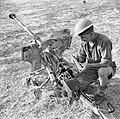Squeeze bore
A squeeze bore, alternatively taper-bore, cone barrel or conical barrel, is a weapon where the internal
Mechanism

A squeeze bore utilizes the energy of the
The squeeze bore concept typically was used in anti-tank guns before the widespread use of shaped charges.[4] Later, the perfection of discarding sabot ammo, which is based on the same concept of using a larger caliber barrel to fire a smaller caliber projectile at high-speed, negated the need for the squeeze bore concept.[2]
History and usage

The squeeze bore concept was first patented by German Karl Puff in 1903, even though the general principle was known already in 19th century and used in Armstrong guns. Later, Hermann Gerlich in the 1920s and 1930s experimented with the concept resulting in an experimental 7cm anti-tank rifle with a 1,800 m/s (5,900 ft/s). This led to the squeeze bore concept sometimes being called the "Gerlich principle".
Between 1939-40, Mauser-Werk AG produced the 2.8 cm sPzB 41 and Krupp (in 1941) produced the 7.5 cm Pak 41. These were eventually discontinued due to the lack of tungsten and manufacturing complexity for the ammunition.[2][7][8]
Other uses of the squeeze bore include the British Littlejohn adaptor, a QF 6-pounder adapter and a version of the M2 machine gun produced during WW2.[5] Squeezing down from 40mm to 30mm, 57mm to 42.6mm, and .50 caliber to .30 caliber respectively. The Littlejohn adapter was used to extend the service life of the QF 2-pounder and was designed by František Janeček whose anglicized name gave the Littlejohn its designation. The QF 6-pounder adapter was never adopted.
Gallery
-
2.8 cm sPzB 41 squeeze-bore anti-tank gun captured by British forces in Sicily 1943.
-
4.2 cm Pak 41 light squeeze-bore anti-tank gun in Italy 1943.
-
A German 10 cm schwere Kanone 18 with an 8,8 cm squeeze-bore adapter attached to the muzzle.[1]
-
AMk VII Tetrarch Mk I with a squeeze-bore Littlejohn adaptor.
See also
Squeeze bore artillery
References
- ^ a b c Rollof, Yngve. "Artillerimaterielens utvecklingstendenser under senaste decenniet". Tidskrift i Sjöväsendet. Number 7 1953 – via Kungliga Örlogsmannasällskapet.
{{cite journal}}:|volume=has extra text (help) - ^ a b c McCollum, Ian (18 February 2017). "Q&A #9: Gas Impingement, Reading List, Squeeze-Bores, and More!". Forgotten Weapons. Youtube. Archived from the original on 2021-12-20. Retrieved 8 July 2018.
- ^ Ankerstjerne, Christian. "Anti-tank Ammunition Types". panzerworld.com.
- ^ a b McCollum, Ian (24 April 2018). "Q&A #17: Bullpups, Stocked Pistols, Delayed Blowback, and More!". Forgotten Weapons. Youtube. Archived from the original on 2021-12-20. Retrieved 6 July 2018.
- ^ a b "Exotic Barrels Part 1: Squeeze Bores | WeaponsMan". weaponsman.com. WeaponsMan. Retrieved 6 July 2018.
- ^ Gerlich, Hermann. "Projectile" (PDF). www.freepatentsonline.com. Free Patents Online. Retrieved 18 July 2018.
- ^ "Squeeze Bore". Shooting with Hobie. 12 January 2011. Retrieved 8 July 2018.
- ^ S, Rusty (20 May 2016). "Mauser's high-tech antitank gun: the 2.8cm sPzB 41 - The Firearm Blog". The Firearm Blog. Retrieved 8 July 2018.



![A German 10 cm schwere Kanone 18 with an 8,8 cm squeeze-bore adapter attached to the muzzle.[1]](http://upload.wikimedia.org/wikipedia/commons/thumb/0/0c/German_10%2C5_cm_squeeze_bore.png/120px-German_10%2C5_cm_squeeze_bore.png)
